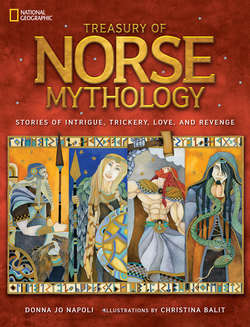Читать книгу Treasury of Norse Mythology: Stories of Intrigue, Trickery, Love, and Revenge - Christina Balit - Страница 7
INTRODUCTION
ОглавлениеDuring the Middle Ages Latin became the language of writing and of much religious storytelling in many lands of Europe. So, for example, in Germany and France people would speak German or French to friends and business associates, but when they wrote books or told Christian stories, they used Latin. The countries in what is today Scandinavia spoke Old Norse, common to all three countries, Norway, Denmark, and Sweden. However, even after Latin writing came to Iceland—which was settled by Norse people—they wrote their own stories in Old Norse, not Latin. In Iceland the tradition of skaldic poetry and song was fundamental to daily culture. People gathered in large halls at any excuse to listen to stories, often because a visiting poet had come to the village. Stories could warm a long cold night, after all. This might well be the reason why some Norse people tenaciously maintained the worldview you will encounter in the stories here until the middle of the 12th century, in opposition to the rising strength of Christianity in neighboring countries.
The Norse stories in many ways reflect the geophysical world the people of Norway and Iceland inhabited. Norway is covered with mountains, the tallest of which are essentially barren—and four are volcanic. Iceland is covered with volcanoes, many of which are active. And both countries have snow and ice in many areas in winter and in some areas even year-round, and each has a long coast lapped by an icy ocean. In such an environment the land and sea themselves must have seemed alive. At any moment the earth might roar, spit fire, and swallow you, or it might shake and an avalanche of snow could smother your homestead. Even a piece of rock, if smacked against a glassy stone, could produce hot sparks that set afire whatever dry twigs were at hand. It’s no wonder then that not just living beings had names, but all sorts of objects had names, too. Bridges and halls, trees and swords, inanimate objects of so many kinds had personalities and powers, and it was important to show respect through calling them by name—and never, never to do so frivolously.
The world must have seemed outrageously dangerous; death waited behind any door, and, oh, how savage that death might be. Nevertheless, these people got in boats and braved seas turbulent with storms as they explored and exploited other worlds. The Norse both paid homage to and defied the unknown. The spirit of courage colors their mythology, even as trickery leads to tragedy. And perhaps facing adversity all the time is at least partly the reason why they had a democratic society in which all free men (not women, and not slaves) had a vote—just as all gods had a vote in the assemblies that the major god, Odin, led. Lives depended on decisions made in communal meetings, so it was best to share both the privilege and the responsibility.
